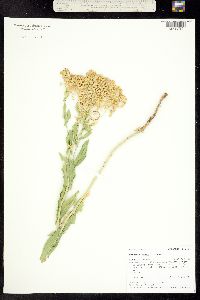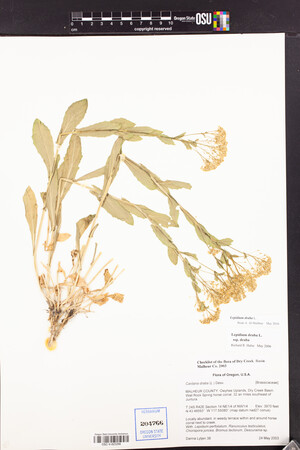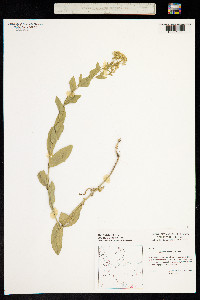Lepidium draba
|
|
|
|
Family: Brassicaceae
globed-podded hoarycress or whitetop, more...Heart-Pod Pepperwort, globed-podded hoarycress, heart-pod hoarycress, heart-podded hoarycress, hoary chess, hoary cress, peppergrass, pepperweed whitetop, whitetop, whitetop or hoary cress, whiteweed
[Cardaria draba (L.) Desv., moreCardaria draba subsp. draba , Cardaria draba var. draba] |
Perennials; (rhizomatous); hirsute or glabrate. Stems often simple from base, erect or decumbent basally, branched (several) distally, (0.8-)2-6.5 (-9) dm. Basal leaves (early withered); not rosulate; petiole 1-4 cm; blade obovate, spatulate, or ovate, (1.5-)3-10(-15) cm × 10-40 mm, margins sinuate to dentate or entire. Cauline leaves sessile; blade ovate, elliptic, oblong, or lanceolate, oblanceolate, or obovate, (1-)3-9(-15) cm × (5-)10-20(-50) mm, base sagittate-amplexicaul or auriculate, margins dentate or entire, (surfaces pubescent or glabrous). Racemes (corymbose panicles), slightly or considerably elongated in fruit; rachis glabrous or puberulent, trichomes straight or curved, cylindrical. Fruiting pedicels ascending to horizontal, straight, (terete), 5-10(-15) × 0.2-0.3 mm, glabrous or sparsely puberulent adaxially. Flowers: sepals oblong to ovate, 1.5-2.5 × 0.7-1.2 mm; petals white, obovate, (2.5-)3-4(-4.5) × (1-)1.3-2(-2.2) mm, claw 1-1.7 mm; stamens 6; filaments 2-3 mm, (glabrous); anthers 0.4-0.5 mm. Fruits (indehiscent), cordate to subreniform, (2-)2.5-3.7(-4.3) × (3.2-)3.7-5(-5.6) mm, apically (obtuse to subacute), not winged, apical notch absent; valves thin, smooth, reticulate-veined, glabrous; style (0.6-)1-1.8(-2) mm. Seeds ovate, 1.5-2.3 × 1-1.3 mm. 2n = 32, 64. Flowering Apr-Aug. Mountain slopes, roadsides, fields, agricultural lands, stream sides, disturbed grounds, pastures, waste areas; 0-3300 m; introduced; Alta., B.C., Man., N.S., Ont., Sask.; Ariz., Calif., Colo., Conn., D.C., Idaho, Ill., Ind., Iowa, Kans., Md., Mass., Mich., Minn., Mo., Mont., Nebr., Nev., N.J., N.Mex., N.Y., N.Dak., Ohio, Okla., Oreg., Pa., R.I., S.Dak., Utah, Wash., Wyo.; s Europe; sw Asia; introduced also in Mexico (Distrito Federal), South America, s Africa, Australia. Although Lepidium draba is poorly established and known from old collections in the eastern part of the United States, it has become a noxious weed in several western states. Lepidium draba and its nearest relatives, L. appelianum and L. chalepense, form a monophyletic clade most closely related to L. campestre (K. Mummenhoff et al. 2001). A. Thellung (1906) and C. L. Hitchcock (1936) correctly placed L. draba in Lepidium, as did Linnaeus. The recognition of the first three species in Cardaria and the maintenance of their nearest relative, L. campestre, in Lepidium do not make any sense on both phylogenetic and taxonomic grounds.
Perennial herb with a thick taproot to 0.6 m tall Leaves: alternate, ascending or upright, clasping, stalkless, to 9 cm long, to 4 cm wide, reduced in size up the stem, oblong to lance-shaped or egg-shaped, bases lobed, tips pointed, sometimes irregularly toothed, densely hairy. Flowers: in dense, branched clusters (raceme), which are borne terminally on the stems. Racemes numerous, often forming a white top across the apex of the plant. Sepals four, free (not attached), whitish green, 2 - 2.5 mm long, to 2 mm wide at apex, hairless or nearly so. Petals four, free (not attached), typically spreading, white, 3 - 4 mm long, bases narrowed. Stamens six. Anthers yellowish orange. Fruit: a short, indehiscent pod (silicle), 2.5 - 3 mm long, 3 - 5 mm wide, nearly spherical, tips pointed, bases heart-shaped, somewhat flattened, hairless or nearly so, evenly divided into two valves. Seeds one per chamber. Stems: multiple from base, vigorously spreading, upright, typically unbranched (but branched in the inflorescence), ribbed, densely hairy below, sparsely hairy above. Roots: creeping. Similar species: No information at this time. Flowering: May to mid-June Habitat and ecology: Introduced from Eurasia. A common weed in fields and waste ground. Also look for it along roads and in other disturbed areas. Occurence in the Chicago region: non-native Etymology: Lepidium comes from the Greek word lepis, meaning scale, which refers to the shape of the silicles. Draba comes from the Greek word drabe, meaning sharp or acrid, which refers to the burning taste of the leaves. Author: The Morton Arboretum Duration: Perennial Nativity: Non-Native Lifeform: Forb/Herb Synonyms: Cardaria draba Erect perennial to 6 dm, vigorously spreading by creeping roots, short-hairy below, less so or glabrate upwards, the sep and fr glabrous or very nearly so; cauline lvs oblong to ovate or obovate, ascending or erect, sessile, au2riculate, irregularly toothed or entire, to 9 נ4 cm; racemes numerous, dense, commonly forming a white top across the summit of the pl; mature pedicels 10-15 mm; sep 2-2.5 mm; fr 2.5-3 נ3-5 mm, somewhat inflated but usually constricted at the narrow partition, cordate or subcordate at base; 2n=32, 64. Fields, roadsides, and waste places; native of the Middle East and e. Mediterranean region, now a serious weed in w. U.S. and adj. Can., and occasionally found in our range. May-July. (Lepidium d.) Gleason, Henry A. & Cronquist, Arthur J. 1991. Manual of vascular plants of northeastern United States and adjacent Canada. lxxv + 910 pp. ©The New York Botanical Garden. All rights reserved. Used by permission. From Flora of Indiana (1940) by Charles C. Deam This species was reported by Hansen in 1927 from Wabash County and in 1925 from Rush County. In 1933 I visited both of these stations and found it to be persisting and spreading as a common weed. In 1935 it was detected along State Road 116 in Wells County by Lawrence E. Hicks of Ohio State University. A large colony was found on the south side of the road in the southwest quarter of sec. 28, west of the railroad and about 200 feet from where the road turns from a westerly direction to the northwest. The colony was about 150 feet long and was mostly on the right of way of the road with only a few plants in the border of the adjacent field. Nieuwland has collected it along a roadside north of Angola, Steuben County. …… Indiana Coefficient of Conservatism: C = null, non-native Wetland Indicator Status: N/A |
|
|
|
























































































